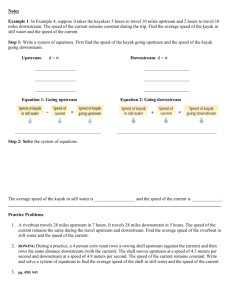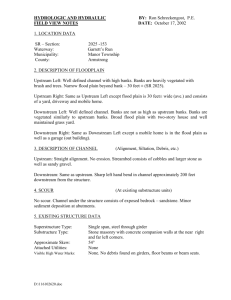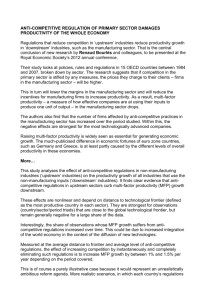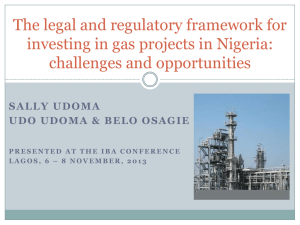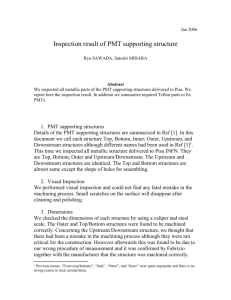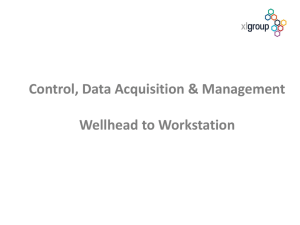Christopher Game (Global Fund)
advertisement
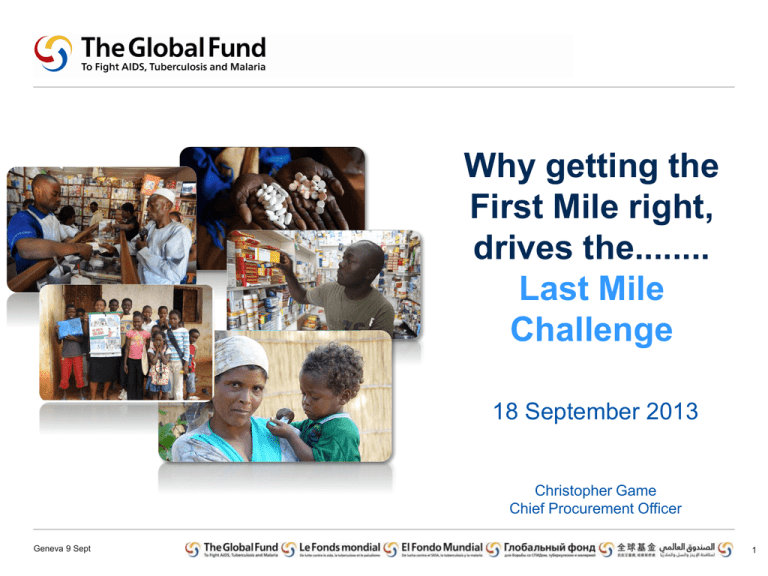
Why getting the First Mile right, drives the........ Last Mile Challenge 18 September 2013 Christopher Game Chief Procurement Officer Geneva 9 Sept 1 What is The Global Fund ? • 4.2 Million • 4.2 Million People currently receiving ARV therapy • 9.7 Million • 9.7 Million New smear-positive TB cases detected and treated • 310 Million • 310 Million Insecticide-treated nets distributed Since its inception in 2002, the Global Fund to Fight AIDS, Tuberculosis and Malaria has become the main multilateral funder in global health . It channels 82 percent of the international financing for TB, 50 percent for malaria, and 21 percent of the international financing against AIDS. It also funds health systems strengthening, as inadequate health systems are one of the main obstacles to scaling up interventions to secure better health outcomes for HIV, TB and malaria. What started as a Procurement Transformation…….. Are directly aligned to the Global Fund’ s strategy The Global Fund will become the benchmark organisation in the sector for Sourcing and Procurement Using simple, clear leading edge processes and tools designed by and for the organisation Minimising waste and eliminating non value adding activities With measurable performance in value and lives saved Ensuring effective governance and watertight compliance Building collaborative relationships with partner agencies suppliers and donors 3 Industry must love us as a sector ? • • • • • • We are silo’d We are fragmented We are impeded by process / bureaucracy We have poor funds flow Inadequate planning & forecasting Much of what we do is outsourced Or perhaps they don’t ? How can we become a customer of choice ? • All of these carry a $ premium • Risk increases with fragmentation • Long lead times reduce system stress at manufacturers 4 What started as a Procurement Transformation…….. Turned into a process for industrializing thought leadership • • • • • • • • • • I soon realised that we are not a customer of choice Many inputs, few outputs Data often out of date and not easily refreshable Slow and operating in silos' That too many are thinking and too few are doing Substantial amount of people feeding at the table Numerous barriers to improvement (agent structures and cash flow) Drugs often mid-late lifecycle Partial aversion or fear of the private sector……in the same sector Our behaviors may erode the incentive to innovate • That upstream leverage irons out some downstream supply issues 5 Working Upstream to improve the Downstream I am going to illustrate how upstream transformation can drive downstream performance What we soon realised :- How we responded :- • • • • • • • • • • • • Lack of Accountability High Agency Costs Multiple Agencies Incentive model Agency ‘local versus Global’ expertise Poor visibility of lost innovation Lack of ownership / supplier relationships Poor funds flow driving wrong behavior Fragmentation = difficult to plan Little competition in pricing Role of many funders largely executional No volume leverage/Many spot purchases • • • • • • • • • • • Subscription, (spend under control) driven by transparency and ease of application Leverage with other large funders / donors to become a customer of choice Agency accountability (track & trace) Vendors incentivized to innovate Creation of product market & supply chain experts Ownership of relationships, up and downstream Greatly improved funds flow ? Cash flow Simple user designed processes Comprehensive market intelligence Frequent price competition Scalable and can be leveraged COGS versus Market based costing 6 Fixing the Plumbing first ? Creating the Ecosystem Upstream partnering facilitating downstream partnering creating the Ecosystem Phase 1 : Creating Partnerships Manufacturers / Logistics Funders Countries 7 Fixing the Plumbing first ? Creating the Ecosystem Upstream partnering facilitating downstream partnering creating the Ecosystem Phase 2 : Creating Capacity and Capability Common Accountability for OTIF Manufacturers / Logistics A Single Ecosystem Underscored by common systems and transparency Funders Countries 8 The Principles of Our Approach Fundamentally changing the way we work across the supply chain to increase access to products Earlier involvement and closer collaboration with manufacturers Improving our purchasing capability and changing our contracting models Optimising the international supply chain to reduce cost Better planning and scheduling to support continuity of supply Delivering more products at the right time and place to more people 9 How we are measuring this ? 1. Develop and implement comprehensive reengineering of the Procurement Operating Model and Organisation. 2. Develop Procurement as a strong partner to create and facilitate Best in Class solutions and delivery for the global fund. 3. Create additional Value of 8% per annum 4. Increase spend penetration by 20% per annum 5. On Time and In Full (OTIF) service to recipient countries to exceed 90 % The Commercial Relationship To ensure we maintain a competitive price in a longer term contractual framework we will need to change our commercial model. 11 i-Fund for The Global Fund Partners Suppliers Knowledge & Collaboration Equipment , Goods and Services team Health Products Team Track & Trace The Support Group GF PSM’s Suppliers Country Ownership & Supply 12 To Reflect – How does fixing the first mile influence the last mile ? How upstream transformation can drive downstream performance Phase 1 (Upstream) :- • Make the Public Sector a customer of choice for the private sector • Leverage funders / buyers • Harmonize specifications • Improve forecasting • View longer term replenishment cycles • Improve planning • Standardize track & trace • Open leverage to smaller buyers +cost of doing business • Pay on time • Create transparency Phase 2 (Downstream) :- • Use savings generated to build country level capacity • Take an academic approach to buffering supply chains • Harmonize regulatory landscape • Create regional centers of excellence building on upstream partner leverage • Make logistics partners accountable and KPI to that accountability 13 Thank You Questions / Discussion 14



